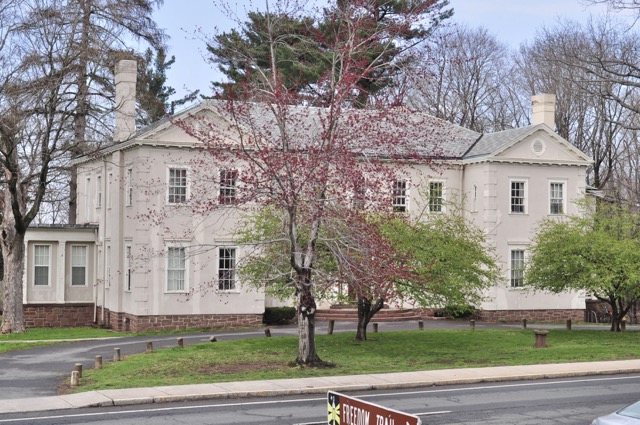
The Office of Residential Life (ResLife) has made the decision to slowly transition Washington Street program housing to more central locations beginning in the 2024-25 academic year, citing issues of safety and potential isolation from the rest of the campus community. Lotus House, currently located at 356 Washington St., will be the first to move, relocating to 267 Court St. in September 2024.
“A long-term goal of Residential Life and Facilities is to center all undergraduate student housing to the South of Washington Street,” Director of ResLife Maureen Isleib wrote in an email to The Argus. “The University will continue to renovate properties to address deferred maintenance issues, increase accessibility and improve general living conditions.”
Program houses currently situated on Washington Street include Art House, Film House, Lotus House, Music House, Full House, and La Casa de Albizu Campos. Art House and Film House are both at 230 Washington St., and can accommodate roughly 30 students. Music House and Full House are situated together at 202 Washington St., which can accommodate almost 40 students. La Casa de Albizu Campos is at 240 Washington St. and can accommodate 8 students. Finally, Lotus House can accommodate 19 students. Overall, around 100 beds will be moved through the Washington Street program housing relocation alone.
One large issue students experience with Washington Street living is its distance from the center of campus, particularly from Usdan University Center and the University’s main academic buildings such as Exley Science Center, the Public Affairs Center (PAC), and Olin Memorial Library. To reach these areas, students have to cross through one or more four-way intersections.
“Crossing Washington Street causes people to feel like it’s much further than other housing and from [University] buildings on campus,” House Manager (HM) of Film House Emma Nielsen ’25 said.
These road crossings have proven to be a cause of concern for the University. The intersection conjoining Washington Street/Connecticut Route 66 and High Street has seen numerous close calls, with students claiming that they were almost hit by passing cars or felt unsafe crossing the street at night. Margery Fang ’26 was hit by an oncoming vehicle while on her bicycle and sustained a concussion from the impact in late 2023.
“I was almost hit multiple times at the intersection because cars tend to take a right on reds,” Fang said.“There was this one time where they did not move at first. As soon as I walked in front of the car…[it] was literally coming at me, chasing me.”
Bon Appétit Management Company cashier Brooke Rich was a victim of a fatal hit-and-run in 2020, as she was crossing the intersection toward Veterans Memorial Green and the Center for African American Studies building. Just feet away from the sidewalk, Rich was hit by a dark-colored car traveling west.
Various non-Wesleyan accidents have occurred within the campus boundary line. These include a crash in front of the Center for Humanities building in May 2023 and a car struck by a fire truck at the intersection in May 2019, which induced hospitalizations.
With these incidents in mind, the Undergraduate Residential Life Committee (URLC), a committee under the Wesleyan Student Assembly (WSA), placed Washington Street housing concerns on the agenda. Co-Chaired by WSA Senator Paul Quach ’26 and Isleib, URLC members meet biweekly, and attendees include Residential Advisors (RAs), HMs, Area Coordinators (ACs) Physical Plant staff, ResLife administrators, and WSA senators.
“During these discussions, we were able to advocate that [living on] Washington Street does create barriers for students,” Quach said. “Not only is housing there farther away from the central campus, but the road is very busy and can be isolating.”
The University has considered selling Lotus House and other similarly far properties like Farm House as recently as 2013, according to a report from the University Planning Committee entitled Washington Street Divestment.
“Each time a program is relocated, the current occupants are involved in the planning for the future location,” former Associate Vice President for Facilities Joyce Topshe wrote in an email to The Argus. “The process has been well received by the students involved in the planning and the new locations have a tendency to increase the popularity of the programs.”
According to Isleib, the University’s Facilities Office had already planned to renovate 267 Court St. for use as a program house before the Lotus House relocation announcement. After consultation with students on the URLC, ResLife recommended Lotus House move into the new space.
The future of 356 Washington St. is yet to be determined.
“I think ResLife plans on eventually repurposing the Lotus House building to serve as grad housing or as an administrative building,” Lotus House HM Isabel Gill ’26 said.
Isleib confirmed that the University does not plan to sell any residential properties.
The new designated spaces for Lotus House and other housing currently being coordinated are anticipated to comply with the Americans with Disabilities Act, and have on-site laundry facilities, and air conditioning. In the case of Lotus House, residents will have the opportunity to design the space.
Students expressed appreciation for the community-building between residents with similar interests in program housing, be it through promoting individual identities or hobbies. Washington Street housing includes some of the most popular program houses, and students will be happy to know that ResLife intends for these houses to stay, though the addresses will change.
“I don’t think there are any problems with the housing [itself],” Nielsen said. “It’s because of the danger of crossing roads, and to have a more central program house area. It’ll make house hopping a lot easier.”
As University program housing revives after COVID-19, creating a more concentrated and lively living area has been central to ResLife policy goals. The eventual relocation of more distant housing options is intended to bring the University community closer together.
Thomas Lyons contributed to reporting.
Carolyn Neugarten can be reached at cneugarten@wesleyan.edu.


Leave a Reply